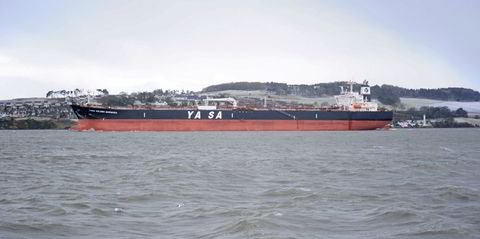Oslo-listed Frontline has given the first hints of the transformative power of its $2.35bn deal to buy 24 modern VLCCs from Euronav last year.
The John Fredriksen-controlled VLCC and suezmax giant said one more tanker remains to be delivered from the fleet acquired in the fourth quarter.
The Oslo-listed company got its hands on 11 ships last year, with 12 more following in January and February.
VLCC spot time charter equivalent earnings averaged $42,300 per day in the fourth quarter, compared with $42,500 in the third period.
Suezmaxes rose to $45,700, against $37,600 previously, while aframax/LR2s went from $33,900 to $42,900.
But for the first quarter, VLCCs stand at $55,100 per day with 81% of days fixed, with suezmaxes on $52,800 from 72% coverage.
Aframax/LRs are making $67,800, with 69% of capacity booked.
The 2024 figures include the impact of the vessels delivered as a result of the acquisition.
Frontline said the final figures should be lower due to the impact of ballast days, however.
The 11 VLCCs delivered in December contributed 184 trading days, net of off-hire periods, of which 150 were ballast days.
This negatively impacted the overall VLCC spot rate by $3,100 per day as limited revenues were recorded, and this was kept out of the final 2023 day rates above.
Profit down in fourth quarter
Net earnings in the last three months dropped to $118.4m, compared with $239m the year before when rates were much higher.
Revenue fell to $415m from $530m.
The owner is paying a dividend of $0.37 per share.
The annual result was $656m, up from $475m in 2022.
Chief executive Lars Barstad said: “Frontline delivered its strongest full-year result in 15 years, despite muted markets in the fourth quarter.”
“The year has been exceptional for the tanker industry and the asset classes we deploy,” he added. “However, it’s the suezmax, aframax and product markets that have offered volatility.”
He said it is a testament to Frontline’s “scalable business platform that within a few months Frontline has doubled its exposure in the VLCC market, by increasing its overall earnings capacity by more than one-third, with minimal impact on its operational set-up.”
Barstad explained that the continuous disruption in the Red Sea has caused West/East trading lanes to widen, “which we believe benefits the larger vessel classes, offering economies of scale as oil and products move around the Cape of Good Hope”.





